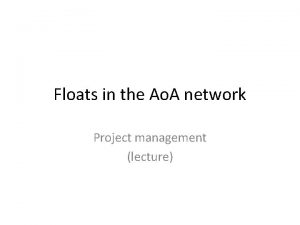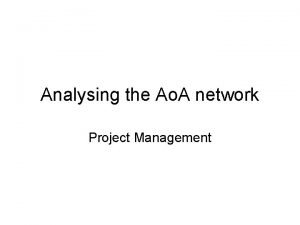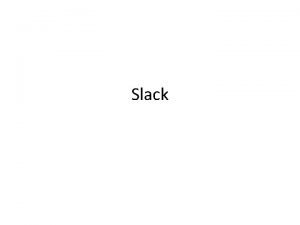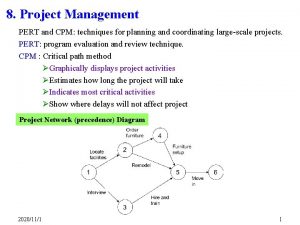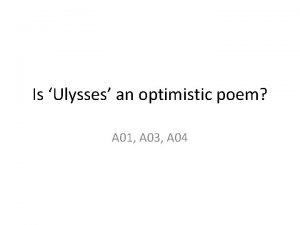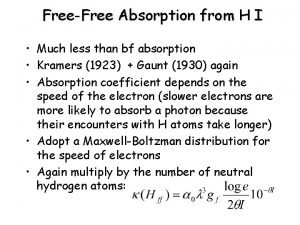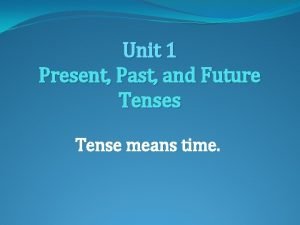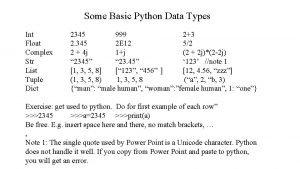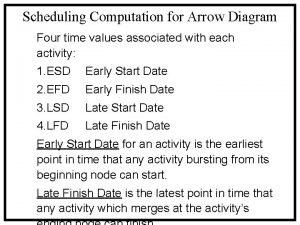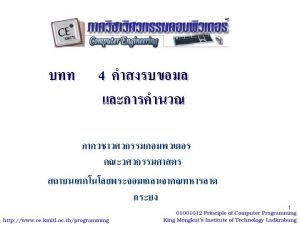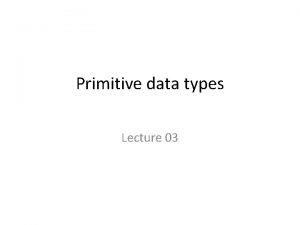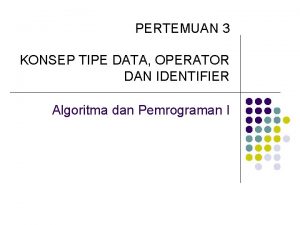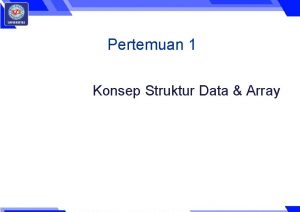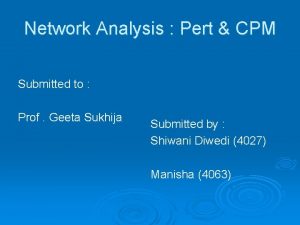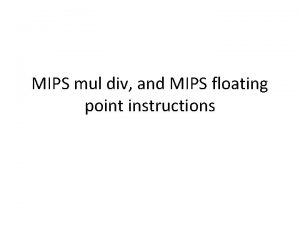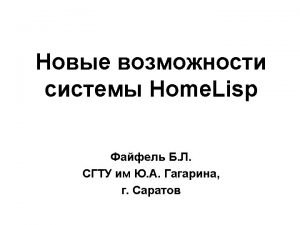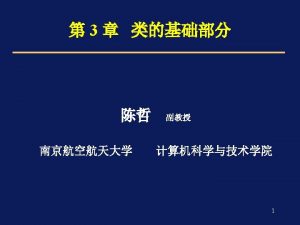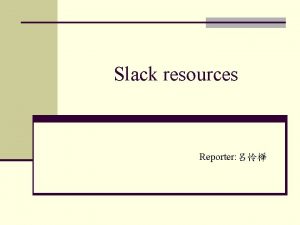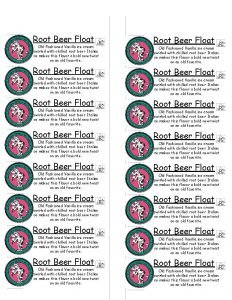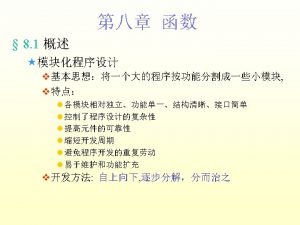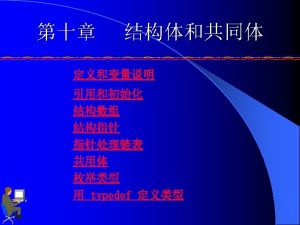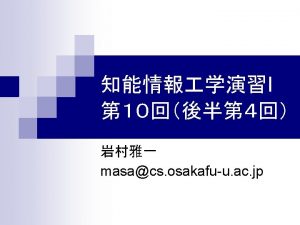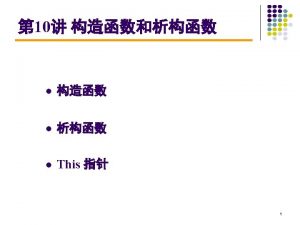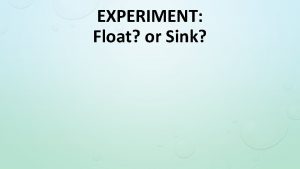Slack Slack or Free Time or Float Slack











![Solution Q 1 Network with ES & EF time 2 5] 0, 5 A[ Solution Q 1 Network with ES & EF time 2 5] 0, 5 A[](https://slidetodoc.com/presentation_image_h/a7a17cb01388b90eed4961eb427d4c61/image-12.jpg)

![Solution Q 1 Network with LS & LF time D[5, 8] 3[7, 10] A[ Solution Q 1 Network with LS & LF time D[5, 8] 3[7, 10] A[](https://slidetodoc.com/presentation_image_h/a7a17cb01388b90eed4961eb427d4c61/image-14.jpg)






![Solution Q 2 1 B [0, 6] 6 [1, 7] , 6] C [4 Solution Q 2 1 B [0, 6] 6 [1, 7] , 6] C [4](https://slidetodoc.com/presentation_image_h/a7a17cb01388b90eed4961eb427d4c61/image-21.jpg)


![Network exercise with time (Q 3) Solution: a. B[0, 6] 6[0, 6] D[ 5[6 Network exercise with time (Q 3) Solution: a. B[0, 6] 6[0, 6] D[ 5[6](https://slidetodoc.com/presentation_image_h/a7a17cb01388b90eed4961eb427d4c61/image-24.jpg)

- Slides: 25

Slack

Slack or Free Time or Float Slack is the length of time an activity can be delayed without affecting the completion date for the entire project. For example, slack for C = 3 weeks, i. e. Activity C can be delayed up to 3 weeks. (start anywhere between weeks 5 and 8). 3 2 ES 5 LS 8 EF 9 ] C [5, 9 ] 2 4 [8, 1 LF 12 LF-EF = 12 – 9 =3 LS-ES = 8 – 5 = 3 LF-ES-t = 12 -5 -4 = 3

1. The earliest start time (EST): the earliest time at which an activity can start if no delays occur in the project; 2. The earliest finish time (EFT): The earliest time at which an activity can finish if no delays occur in the project; 3. The latest start time (LST): The latest time at which an activity can start without delaying the completion of the project; 4. The latest finish time (LFT): The latest time at which an activity can finish without delaying the completion of the project. A forward pass (from the starting node to the finish node) is used to compute the EST and EFT, whereas a backward pass (from the finish node to the starting node) is used for the LST and LFT. Slack = LS-ES = LF-EF

Slack The slack time for an activity refers to the length of time that can be tolerated without incurring a delay in the scheduled project completion time. The slack time per activity needs to be calculated first to identify the critical path(s), by considering either the start times or the finish times. Hence, for each of the activities in the project network, the slack time can be calculated as follows: Slack = LST- EST or LFT- EFT

Arc with ES & EF time EF = earliest finish time ES = earliest start time Activity 2 A [0, 5 5 ] 1 t = expected activity time

Activity, duration, ES, EF, LS, LF EF = earliest finish time ES = earliest start time Activity 3 2 ] C [5, 9 ] 2 4 [8, 1 LF = latest finish time LS = latest start time

Importance of Float (Slack) and Critical Path 1. Slack or Float shows how much allowance each activity has, i. e how long it can be delayed without affecting completion date of project. 2. Critical path is a sequence of activities from start to finish with zero slack. Critical activities are activities on the critical path. 3. Critical path identifies the minimum time to complete project. 4. If any activity on the critical path is shortened or extended, project time will be shortened or extended accordingly.

Importance of Float (Slack) and Critical Path (cont) 5. So, a lot of effort should be put in trying to control activities along this path, so that project can meet due date. If any activity is lengthened, be aware that project will not meet deadline and some action needs to be taken. 6. If you can spend resources to speed up some activity, do so only for critical activities. 7. Don’t waste resources on non-critical activity, it will not shorten the project time. 8. If resources can be saved by lengthening some activities, do so for non-critical activities, up to limit of float.

Question 1 A. Find the AOA network. B. Determine all the slacks. Activity A B C D E F G H I Immediate predecessors A A A E D, F B, C G, H Completion Time (week) 5 6 4 3 1 4 14 12 2

Solution Q 1 A. AOA Network D 3 2 1 F 4 E 4 5 G 14 A 5 C 4 1 6 B 3 H 12 6 The critical path: AEFGI =26 Weeks I 2 7

Earliest start & earliest finish time • We are interested in the longest path through the network, i. e. , the critical path. • Starting at the network’s origin (node 1) and using a starting time of 0, we compute an earliest start (ES) and earliest finish (EF) time for each activity in the network. • This process of starting with the initial activities and working forward in time toward the final activities to calculate all the ES and EF values is referred to as making a forward pass through the network. • The expression EF = ES + t can be used to find the earliest finish time for a given activity. For example, for activity A, ES = 0 and t = 5; thus the earliest finish time for activity A is EF = 0 + 5 = 5
![Solution Q 1 Network with ES EF time 2 5 0 5 A Solution Q 1 Network with ES & EF time 2 5] 0, 5 A[](https://slidetodoc.com/presentation_image_h/a7a17cb01388b90eed4961eb427d4c61/image-12.jpg)
Solution Q 1 Network with ES & EF time 2 5] 0, 5 A[ C[5, 9] 4 1 5 10] 4 F[6, 4 G[10, 24] 14 E[5 , 1 6] D[5, 8] 3 B[0 , 6 6 ] 3 H[9, 21] 12 6 I [24, 26] 2 7 Earliest start time rule: The earliest start time for an activity leaving a particular node is equal to the largest of the earliest finish times for all activities entering the node. The earliest start time of an activity is equal to the largest of the earliest finish times of its immediate predecessors. In symbols, ES = largest EF of the immediate predecessors.

Latest start & latest finish time • On the critical path Slack = 0. • To start with the final activities and work backward in time toward the initial activities to calculate all the LF and LS values, we now are making a backward pass through the network. • Starting at the completion point (node 7) and using a latest finish time (LF) of 26 for activity I, we trace back through the network computing a latest start (LS) and latest finish time for each activity • The expression LS = LF – t can be used to calculatest start time for each activity. For example, for activity I, LF = 26 and t = 2, thus the latest start time for activity I is LS = 26 – 2 = 24
![Solution Q 1 Network with LS LF time D5 8 37 10 A Solution Q 1 Network with LS & LF time D[5, 8] 3[7, 10] A[](https://slidetodoc.com/presentation_image_h/a7a17cb01388b90eed4961eb427d4c61/image-14.jpg)
Solution Q 1 Network with LS & LF time D[5, 8] 3[7, 10] A[ 3 4 H[9, 21] 12[12, 24] 5 G[10, 24] 14[10, 24] B[0 6[6 , 6] , 12 ] C[5, 9] 4[8, 12] 1 0] 1 , 6 F[ 10] 4[6, , 6] E[5 5, 6] 1[ 5[ 0, 5] 2 6 I [24, 26] 2[24, 26] 7 Latest finish time rule: The latest finish time for an activity entering a particular node is equal to the smallest of the latest start times for all activities leaving the node. The latest finish time of an activity is equal to the smallest of the latest start times of its immediate successors. In symbols, LF = smallest LS of the immediate successors.

Solution Q 1 Activity schedule Activity Earliest start Latest (ES) start (LS) Earliest finish (EF) Latest finish (LF) Slack (LS-ES)=(LF –EF) Critical path A 0 0 5 5 0 Yes B 0 6 6 12 6 C 5 8 9 12 3 D 5 7 8 10 2 E 5 5 6 6 0 Yes F 6 6 10 10 0 Yes G 10 10 24 24 0 Yes H 9 12 21 24 3 I 24 24 26 26 0 Yes

Solution Q 1 QUESTIONS • What is the total time to complete the project? – 26 weeks if the individual activities are completed on schedule. • What are the scheduled start and completion times for each activity? – ES, EF, LS, LF are given for each activity. • What activities are critical and must be completed as scheduled in order to keep the project on time? – Critical path activities: A, E, F, G, and I.

Question 2 Network exercise with time Construct AOA network for a project with the following activities and times: Activity A B C D E F G Immediate Predecessor A A C, B D, E Time (months) 4 6 2 6 3 3 5 a) Find the critical path for this project network. b) Determine all slacks and show it on the network. 17

Solution Q 2 Solution – first construct the network and label activities D 2 4 G A E C 1 B F 5 3 18

Solution Q 2 D 6 2 G 5 C 2 A 4 4 E 1 3 B 6 3 Paths: 1. ADG-15 3. ACF-9 5. BF-9 5 F 3 2. ACEG-14 4. BEG-14 19

Solution Q 2 Solution D 6 2 4 G 5 5 3 1 E C 2 A 4 B 6 3 F 3 a. Critical path: A-D-G; Time: 15 months. b. Activities on the critical path require 15 months to complete. Thus the project should easily be completed in 1 20 1/2 years even if some activities take longer than expected.
![Solution Q 2 1 B 0 6 6 1 7 6 C 4 Solution Q 2 1 B [0, 6] 6 [1, 7] , 6] C [4](https://slidetodoc.com/presentation_image_h/a7a17cb01388b90eed4961eb427d4c61/image-21.jpg)
Solution Q 2 1 B [0, 6] 6 [1, 7] , 6] C [4 , 7] 2 [5 , 4] 0 [ A , 4] 4 [0 D [4, 10] 6 [4, 10] E[ 3 [ 6, 9] 7, 1 0] 2 3 4 G[ 5 [ 10, 1 10 5] , 15 ] F [ 6, 9] 5] 3 [12, 1 5 a. Critical path: A-D-G; Time: 15 months b. Activities on the critical path require 15 months to complete. Thus the project should easily be completed in 1 1/2 years even if some activities take longer than expected. 21

Solution Q 2 Activity schedule Activity Earliest start Latest (ES) start (LS) Earliest finish (EF) Latest finish (LF) Slack (LS-ES)=(LF –EF) A 0 0 4 4 0 B 0 1 6 7 1 C 4 5 6 7 1 D 4 4 10 10 0 E 6 7 9 10 1 F 6 12 9 15 6 G 10 10 15 15 0 Critical path Yes Yes

Question 3 A project involving the installation of a computer system consists of eight activities. The immediate predecessor and activity time in weeks are shown below: Activity Immediate Time Predecessor (weeks) A 3 B 6 C A 2 D B, C 5 E D 4 F E 3 G B, C 9 H F, G 3 a. b. c. d. Draw the PERT/CPM network for this project. Determine all slacks. What are the critical path activities? What is the expected project completion time? 23
![Network exercise with time Q 3 Solution a B0 6 60 6 D 56 Network exercise with time (Q 3) Solution: a. B[0, 6] 6[0, 6] D[ 5[6](https://slidetodoc.com/presentation_image_h/a7a17cb01388b90eed4961eb427d4c61/image-24.jpg)
Network exercise with time (Q 3) Solution: a. B[0, 6] 6[0, 6] D[ 5[6 6, 11] , 11 ] A[ 0 3[1 , 3] , 4] , 5] C[3 , 6] 2[4 1 3 G[6, 15] 9[9, 18] 5, 1 ] F[1 5, 18 3[1 4 E[11, 15] 4[11, 15] 2 6 H[18, 21] 3[18, 21] 7 b. Critical path activities: B - D - E - F - H c. Expected project completion time =21 weeks 24

Network exercise with time (Q 3) Activity A B C D E F G H ES 0 0 3 6 11 15 6 18 LS 1 0 4 6 11 15 9 18 EF 3 6 5 11 15 18 15 21 LF 4 6 6 11 15 18 18 21 Slack 1 0 0 0 3 0 Critical? Yes Yes Yes Critical path activities: B - D - E - F - H 25
 Eft revision task
Eft revision task What is free float and total float
What is free float and total float Est eft lst lft
Est eft lst lft Float slack
Float slack Dummy activity in network diagram
Dummy activity in network diagram For minutes. start.
For minutes. start. Gibbs free energy equation
Gibbs free energy equation Negative free energy change
Negative free energy change Gibs free energy
Gibs free energy Kernel dynamic memory
Kernel dynamic memory Helmholtz free energy
Helmholtz free energy Free hearts free foreheads you and i are
Free hearts free foreheads you and i are The story of an hour summary
The story of an hour summary Free-free absorption
Free-free absorption Ball float backwater valve
Ball float backwater valve Rokko float
Rokko float Present continuous in future
Present continuous in future Complex float python
Complex float python Independent float
Independent float Int float
Int float Int char float
Int char float Tipe data float
Tipe data float Contoh struktur data
Contoh struktur data Pert and cpm difference
Pert and cpm difference Mips read float
Mips read float N' python
N' python

